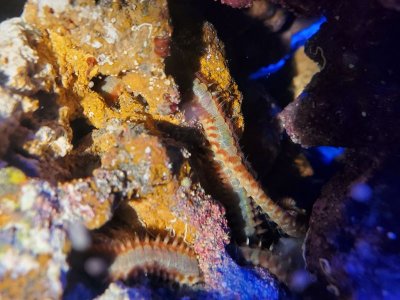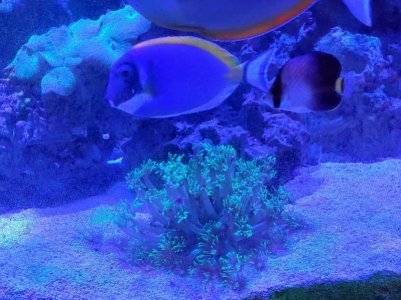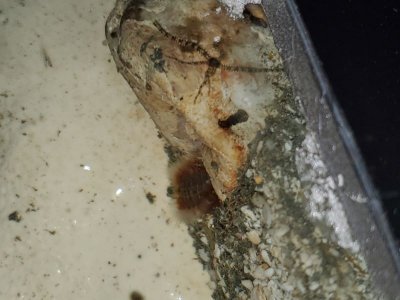Actuarial Goat
New member
Hoping that thread title is provocative enough...
I've done three different FOWLR tanks over time, so I'm not new per se. I now have a 220 basic reef....essentially I'm just introducing soft corals slowly and trying to build a fish list that will cooperate (so no angels)...(OK, maybe a dwarf or two)...but I've never experienced the kind of fish death I'm seeing in this tank, which really sucks because this one is by far my biggest, most expensive and intentional effort to date.
My question is, do we have a list of cause of fish death, maybe sorted by likelihood :lmao:? I have had many deaths over the course of this particular tank, thought we had taken care of everything, and now I have a new onslaught and I'm getting to my wits end. Just over the last 24 hours, I lost a Flame Angel, a Vagabond butterfly, and my beloved green mandarin, who was huge and ate like crazy right up to the end and has been in there for 6 months. A week ago I lost a fat 5" square back Anthias. A month before that was a Coral Beauty.
Worth noting that of all these deaths, only the Coral Beauty and Mandarin were found. The others just fully disappeared, even the Anthias. The Mandarin did have a tiny bit of brand new wear and tear on his front dorsal fin.
All these fish were QT'd, all had been in the tank beyond what I would think of as "new fish stress" (more than a month). The only signs of stress on any fish is a Desjardini Sailfin, who has been in there for a year and has significant HLLE that started around 6 months ago. But I also have several other good size fish (naso tang, hippo tang, powder blue) with no signs of illness or stress at all. Everyone eats and is active.
My only thoughts are:
(1) parasite. I have used PraxiPro on my last 3 quarantines, of which the Flame and Butterfly were a part, but I did not use it prior to that, so the Mandarin did not get it. But wouldn't they show symptoms before just kicking off?
(2) a contaminant that I'm not testing for
(3) a predator that I don't know about. We did have a 5ft long Eunicid worm toward the beginning (yes 5 feet, I have pictures) but I got him out. My wife is convinced it's one of the bristle worms...I'm telling her that's not how it works, but in her defense, there are a few massive ones (over a foot) in there.....and one of them is a different red color than the other grey ones (so maybe a fire worm? Could it do this?)
Anyway, any help on fish death is what I'm looking for. Early answers to the basic questions:
220 gallon, up and running for a year
No ammonia, no nitrite, ~20 nitrate, 8.2 pH
SG is currently 1.0285...I know it's high but it didn't get there over night, and I'm going to bring it back down with some water changes
There seems to be no rhyme or reason to the deaths....some are new(er) additions, some have been there almost since the beginning.
HELP!!! :headwallblue:
I've done three different FOWLR tanks over time, so I'm not new per se. I now have a 220 basic reef....essentially I'm just introducing soft corals slowly and trying to build a fish list that will cooperate (so no angels)...(OK, maybe a dwarf or two)...but I've never experienced the kind of fish death I'm seeing in this tank, which really sucks because this one is by far my biggest, most expensive and intentional effort to date.
My question is, do we have a list of cause of fish death, maybe sorted by likelihood :lmao:? I have had many deaths over the course of this particular tank, thought we had taken care of everything, and now I have a new onslaught and I'm getting to my wits end. Just over the last 24 hours, I lost a Flame Angel, a Vagabond butterfly, and my beloved green mandarin, who was huge and ate like crazy right up to the end and has been in there for 6 months. A week ago I lost a fat 5" square back Anthias. A month before that was a Coral Beauty.
Worth noting that of all these deaths, only the Coral Beauty and Mandarin were found. The others just fully disappeared, even the Anthias. The Mandarin did have a tiny bit of brand new wear and tear on his front dorsal fin.
All these fish were QT'd, all had been in the tank beyond what I would think of as "new fish stress" (more than a month). The only signs of stress on any fish is a Desjardini Sailfin, who has been in there for a year and has significant HLLE that started around 6 months ago. But I also have several other good size fish (naso tang, hippo tang, powder blue) with no signs of illness or stress at all. Everyone eats and is active.
My only thoughts are:
(1) parasite. I have used PraxiPro on my last 3 quarantines, of which the Flame and Butterfly were a part, but I did not use it prior to that, so the Mandarin did not get it. But wouldn't they show symptoms before just kicking off?
(2) a contaminant that I'm not testing for
(3) a predator that I don't know about. We did have a 5ft long Eunicid worm toward the beginning (yes 5 feet, I have pictures) but I got him out. My wife is convinced it's one of the bristle worms...I'm telling her that's not how it works, but in her defense, there are a few massive ones (over a foot) in there.....and one of them is a different red color than the other grey ones (so maybe a fire worm? Could it do this?)
Anyway, any help on fish death is what I'm looking for. Early answers to the basic questions:
220 gallon, up and running for a year
No ammonia, no nitrite, ~20 nitrate, 8.2 pH
SG is currently 1.0285...I know it's high but it didn't get there over night, and I'm going to bring it back down with some water changes
There seems to be no rhyme or reason to the deaths....some are new(er) additions, some have been there almost since the beginning.
HELP!!! :headwallblue:




